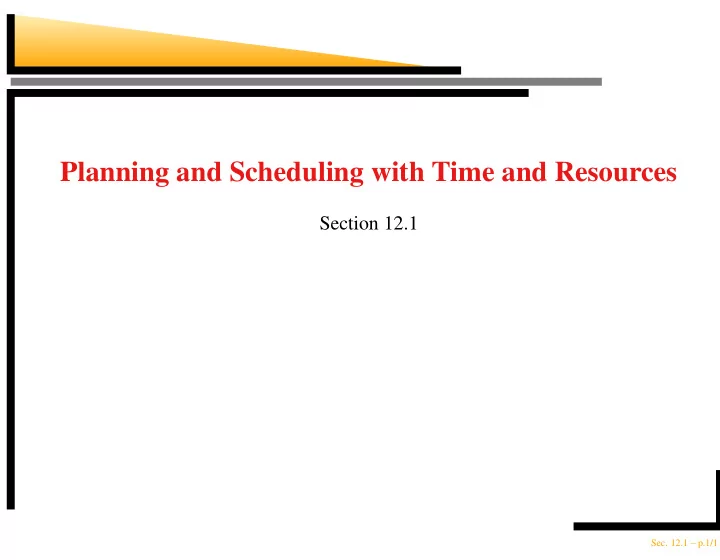

Planning and Scheduling with Time and Resources Section 12.1 Sec. 12.1 – p.1/11
Outline Scheduling problems vs. planning problems Scheduling with time constraints Scheduling with resource constraints Additional references used for the slides: Smith , D.E, Frank, J. and Jonsson, A. K. (2000). Bridging the Gap Between Planning and Scheduling. Knowledge Engineering Review , 15(1). Kambhampati , S. (2000). AI Planning tutorial notes. AAAI-2000 . Sec. 12.1 – p.2/11
Planning vs. scheduling Planning Involves choice of actions Cannot deal with time and resource constraints Scheduling Can easily represent time and resource constraints Cannot deal with action choices Most real world problems are optimization problems that involve continuous time, resources, metric quantities, and a complex mixture of action choices and ordering decisions. Sec. 12.1 – p.3/11
Planning vs. scheduling Planning problem Scheduling problem Initial state, goals set of jobs (possibly partially ordered) action descriptions temporal constraints on jobs (EST, LFT, duration) resource constraints Synthesize a sequence Assign optimal start of actions times and resources Sec. 12.1 – p.4/11
Dealing with time EST : earliest start time LFT : latest finish time duration CPM : critical path method. A path is a sequence of actions that depend on each other. A critical path is the longest path. Delaying it would delay the entire plan. Sec. 12.1 – p.5/11
� ✄ ✄ ✁ ✝ ✝ ✄ ☎ ☎ � ☎ ✆ ✁ ✄ ✁ ✁ � ✄ ✁ ✆ ✄ ✄ ✄ ✄ ✄ ✄ ✄ ✄ � Example Init (Chassis( �✂✁ ) Chassis( �✂☎ ) Engine( , ,30) Engine( , ,60) �✂☎ Wheels( , ,30) Wheels( , ,15)) Goal(Done( ) Done( �✂☎ )) Action(AddEngine(e,c), P RECOND : Engine(e,c,d) Chassis(c) EngineIn(c) ✄✟✞ E FFECT : EngineIn(c) Duration(d)) Action(AddWheels(w,c), P RECOND : Wheels(w,c,d) Chassis(c) E FFECT : WheelsOn(c) Duration(d)) Action(Inspect(c), P RECOND : EngineIn(c) WheelsOn(c) Chassis(c) E FFECT : Done(c) Duration(10)) Sec. 12.1 – p.6/11
Example [0,15] [30,45] [60,75] AddEngine1 Addwheels1 Inspect1 30 30 10 [0,0] [85,85] Start Finish [0,0] [60,60] [75,75] AddEngine2 Addwheels2 Inspect2 60 15 10 AddWheels1 AddEngine1 Inspect1 AddEngine2 Inspect2 AddWheels2 0 10 20 30 40 50 60 70 80 90 Sec. 12.1 – p.7/11
Dealing with resources reusable resource : is occupied during an action, and is freed afterwards aggregation of resources : group indistinguishable resources into quantities Minimum slack algorithm : a greedy algorithm Sec. 12.1 – p.8/11
✄ ✄ ✁ � ✁ ✄ ✝ ☎ � ☎ ✄ ✄ ✄ ✄ ✄ ✄ � ✁ ✄ ✄ ✄ ✄ ✝ � ✄ ✄ � ✄ ✆ ☎ ✆ ✁ ☎ ✁ Example Init (Chassis( �✂✁ ) Chassis( �✂☎ ) Engine( , ,30) Engine( , ,60) Wheels( , ,30) Wheels( , ,15) EngineHoists(1) WheelStations(1) Inspectors(2)) Goal(Done( ) Done( )) �✂☎ Action(AddEngine(e,c), P RECOND : Engine(e,c,d) Chassis(c) EngineIn(c) ✄✟✞ E FFECT : EngineIn(c) Duration(d) R ESOURCE : EngineHoists(1)) Action(AddWheels(w,c), P RECOND : Wheels(w,c,d) Chassis(c) E FFECT : WheelsOn(c) Duration(d) R ESOURCE : WheelStations(1)) Action(Inspect(c), P RECOND : EngineIn(c) WheelsOn(c) Chassis(c) E FFECT : Done(c) Duration(10) R ESOURCE : Inspectors(1)) Sec. 12.1 – p.9/11
Example AddEngine1 AddEngine2 EngineHoists(1) AddWheels1 AddWheels2 WheelStations(1) Inspect1 Inspectors(2) Inspect2 0 10 20 30 40 50 60 70 80 90 100 110 120 Sec. 12.1 – p.10/11
Planner-scheduler interface Causal plan Planner Scheduler Optimal schedule Each can do its own job. The big question is how best to couple them to avoid inter-module trashing. The second big question is which planners are most suitable for coupling. Sec. 12.1 – p.11/11
Recommend
More recommend